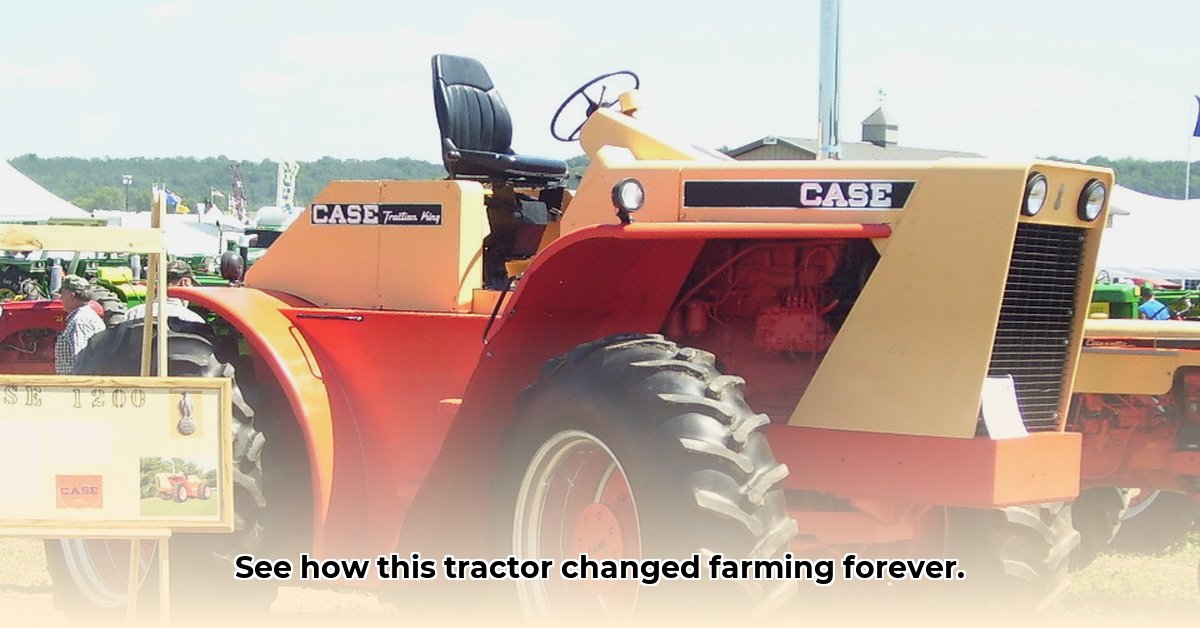
The 1960s agricultural landscape demanded more powerful machinery. Two-wheel-drive tractors struggled with increasingly large fields and heavier implements, particularly in challenging conditions. Enter the Case 1200 Traction King, a four-wheel-drive giant that promised – and largely delivered – unprecedented power and traction. For more on Case tractors, check out this Case Tractor History page. This article delves into the Case 1200's technical specifications, historical context, market impact, limitations, and lasting legacy, offering a comprehensive retrospective of this pivotal machine.
The Case 1200: A Technological Colossus
The Case 1200's defining feature was its innovative four-wheel-drive system, providing superior traction compared to its two-wheel-drive counterparts. But how powerful was it, exactly? Sources cite PTO horsepower figures ranging from 119.9 to 120, a discrepancy possibly arising from variations in testing methodologies or slight differences between individual units. Regardless of the precise number, it represented a substantial power increase over contemporary tractors. This enhanced power translated into increased productivity, with farmers able to tackle larger fields and heavier implements with greater ease. Was this increase in power sufficient to justify its adoption? The answer lies in its overall market impact.
Under the Hood: The Lanova Engine and its Challenges
Powering the Case 1200 was a state-of-the-art turbocharged Lanova engine. This technology, while innovative for its time, presented some reliability issues. High exhaust gas temperatures (EGTs) were a recurring problem, leading to premature engine wear in some instances. Did these issues outweigh the benefits of increased power and traction? The answer depends on the perspective of individual farmers; clearly, others felt it provided a net positive impact.
Market Impact and the Rise of Four-Wheel Drive
Despite the Lanova engine's occasional unreliability, the Case 1200 enjoyed considerable market success, with approximately 1,549 units sold. This demonstrated a clear demand for high-traction, high-power tractors. Furthermore, its relatively affordable price point (considering its capabilities) broadened its appeal amongst a wider range of farmers. The Case 1200 didn't merely sell; it set a trend, significantly influencing the adoption of four-wheel-drive technology by other manufacturers. How significant was this adoption of four-wheel drive? It permanently shifted agricultural machinery design.
Limitations and Design Compromises
The Case 1200 wasn't without its flaws. The Lanova engine's reliability problems, as previously mentioned, were a notable concern. Other design compromises, potentially born from constraints in a rapidly developing machine, also existed. These imperfections highlight the challenges associated with pioneering new technologies. Were these limitations significant enough to negate its overall impact on farming? Undoubtedly, they present a balanced perspective of its successes.
Long-Term Legacy and Sustainability
The Case 1200's impact extends beyond its immediate sales figures. Its increased power and efficiency led to greater productivity, allowing farmers to cultivate more land in less time. This had indirect consequences for sustainability. While increased efficiency is generally positive, it's important to note that the Lanova engine, by modern standards, was comparatively less fuel-efficient and emitted more pollutants than current designs. The question arises: How did the Case 1200's design choices influence its long-term sustainability? It was a tool for a specific era, and its environmental impact demands a nuanced evaluation.
Conclusion: A Pivotal Moment in Agricultural History
The Case 1200 Traction King represents a pivotal moment in agricultural mechanization. While not without flaws, its introduction marked a significant advance in tractor technology and profoundly influenced the industry's trajectory. Its enduring legacy lies not only in its market success but, more importantly, in its contribution to the widespread adoption of four-wheel-drive tractors, forever changing the nature of farming.
Key Takeaways:
- The Case 1200 significantly increased farming efficiency through its powerful four-wheel-drive system.
- The Lanova engine, while innovative, presented reliability challenges.
- The tractor's success spurred the industry's widespread adoption of four-wheel-drive technology.